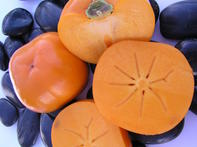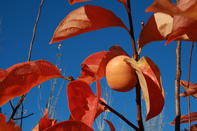Cultivated Persimmons
Persimmons are the edible fruit of trees in the genus Diospyros in the family Ebenaceae. The word Diospyros comes from the ancient Greek, which means "divine fruit".

The American persimmon (D. virginiana), grows from the Gulf states north to central Pennsylvania and central Illinois. The fruit is 3 to 5 cm in diameter, usually rather flattened, and dark red to maroon in colour. Most fruits contain several rather large flattened seeds. Several superior varieties have been named and propagated and are grown commercially.
The most widely cultivated persimmons are the Asian persimmon, Diospyros Kaki or Kaki Fruit. The Asian or Japanese persimmon is native to China, where it has been cultivated for centuries and more than two thousand different cultivars exist. It spread to Korea and Japan many years ago where additional cultivars were developed and then spread internationally during the 19th century.
Persimmons are produced on deciduous trees and prior to losing their elongated leaves, the leathery, glossy bluish-green persimmon leaves turn a dramatic bright yellow and deep orange, before dropping in the winter.
The cultivated trees are pruned annually but if left unpruned, the trees can grow up to 10 m in height. The trees start to bear fruit after three years, but only reach full potential after eight years and the life expectancy of healthy trees is around 40 years. A top yield of up to 50 t/ha has been recorded in some of the best-producing orchards.
Flowering occurs during spring and Kaki Fruit ripens to maturity in late autumn. The fruit of various varieties differs from a light yellow-orange to dark red-orange. They also vary in size from 1.5 to 9 cm in diameter and their shapes vary from spherical to oval and pumpkin shaped.
The most commonly produced Kaki Fruit are flattened slightly on top and bottom with squarish facets and have a shape resembling a large tomato. The skin is smooth and edible, and the fruit has a distinctive bright orange colour.
Astringent and Non-astringent Persimmons
Persimmons are classified into two general categories, those bearing fruit that is astringent until soft ripe and those whose fruit is not astringent. Non-astringent persimmons can be eaten when ripe like an apple. The most commonly produced persimmons, Kaki Fruit are astringent persimmons.
The fruit requires a post-harvest gas exposure process in order to remove the astringency from the fruit before the fruit is edible and marketed. When the fruit is harvested, it is astringent and virtually inedible due to high tannin levels, but this process matures the fruit and converts it into a deliciously sweet fruit.
Once the fruit has been packaged it is treated with either ethylene gas or carbon dioxide in specialized treatment chambers for a number of hours or days, depending on the type of treatment. These are both common gasses and this treatment is not harmful to consumers.
The gas treatment removes the high levels of tannin in the fruit and produces firm, high-quality fruits with jelly-like texture, sweet taste, and good orange colour ready for marketing.
Nutritional Value

Kaki Fruit is very rich in vitamin B2 (riboflavin) and vitamin B1 (thiamin) and packed with carotenoids, which are known for their positive effect on lowering the risk of heart disease and certain cancers. The fruit contains twice as much fibre as that found in apples and also contains elements such as calcium, iron and magnesium.